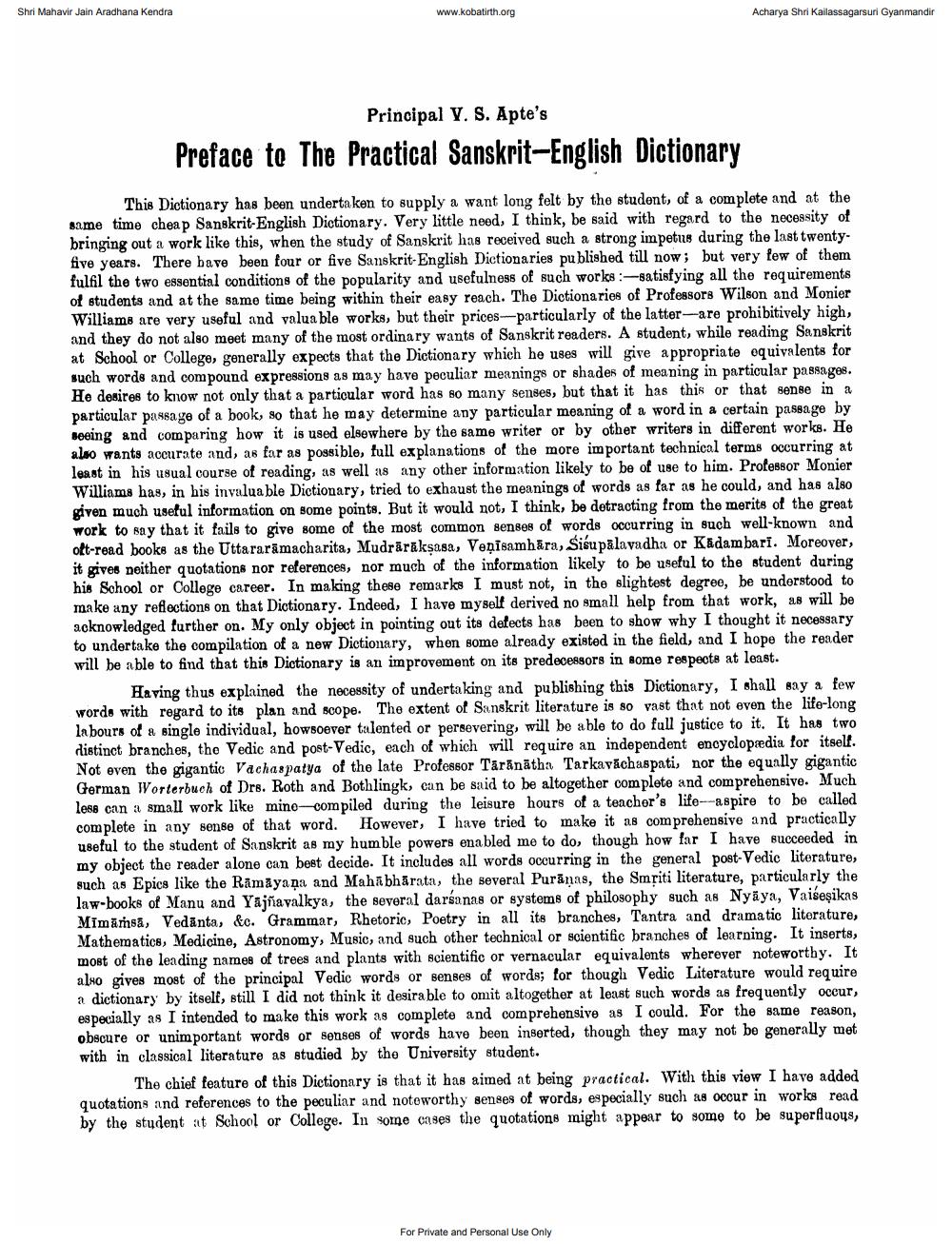Book Title: Sanskrit English Dictionary Part 01 Author(s): P K Gode, C G Karve Publisher: Prasad Prakashan View full book textPage 5
________________ Shri Mahavir Jain Aradhana Kendra www.kobatirth.org Acharya Shri Kailassagarsuri Gyanmandir Principal Y. S. Apte's Preface te The Practical Sanskrit-English Dictionary This Dictionary has been undertaken to supply a want long felt by the students of a complete and at the same time cheap Sanskrit-English Dictionary. Very little need, I think, be said with regard to the necessity of bringing out a work like this, when the study of Sanskrit has received such a strong impetus during the last twentyfive years. There bave been four or five Sanskrit-English Dictionaries published till now; but very few of them fulfil the two essential conditions of the popularity and usefulness of such works :-satisfying all the requirements of students and at the same time being within their easy reach. The Dictionaries of Professors Wilson and Monier Williams are very useful and valuable works, but their prices--particularly of the latter--are prohibitively high, and they do not also meet many of the most ordinary wants of Sanskrit readers. A student, while reading Sanskrit at School or College, generally expects that the Dictionary which he uses will give appropriate equivalents for such words and compound expressions as may have peculiar meanings or shades of meaning in particular passages. He desires to know not only that a particular word has so many senses, but that it has this or that sense in a particular passage of a book, so that he may determine any particular meaning of a word in a certain passage by seeing and comparing how it is used elsewhere by the same writer or by other writers in different works. He also wants accurate and, as far as possible, full explanations of the more important technical terms occurring at least in his usual course of reading, as well as any other information likely to be of use to him. Professor Monier Williams has, in his invaluable Dictionary, tried to exhaust the meanings of words as far as he could, and has also given much useful information on some points. But it would not, I think, be detracting from the merits of the great work to say that it fails to give some of the most common senses of words occurring in such well-known and oft-read books as the Uttararamacharita, Mudrāraksasa, Venisamhara, Sisu palavadha or Kadambari. Moreover, it gives neither quotations nor references, nor much of the information likely to be useful to the student during his School or College career. In making these remarks I must not, in the slightest degree, be understood to make any reflections on that Dictionary. Indeed, I have myselt derived no small help from that work, as will be acknowledged further on. My only object in pointing out its defects has been to show why I thought it necessary to undertake the compilation of a new Dictionary, when some already existed in the field, and I hope the reader will be able to find that this Dictionary is an improvement on its predecessors in some respects at least. Having thus explained the necessity of undertaking and publishing this Dictionary, I shall say a few words with regard to its plan and scope. The extent of Sanskrit literature is so vast that not even the life-long labours of a single individual, howsoever talented or persevering, will be able to do full justice to it. It has two distinct branches, the Vedic and post-Vedic, each of which will require an independent encyclopædia for itself. Not even the gigantic Vachas patya of the late Professor Taranātha Tarkavichaspati, nor the equally gigantic German Worterbuch of Drs. Roth and Bothlingk, can be said to be altogether complete and comprehensive. Much less can a small work like mine-compiled during the leisure hours of a teacher's life--aspire to be called complete in any sense of that word. However, I have tried to make it as comprehensive and practically useful to the student of Sanskrit as my humble powers enabled me to do, though how far I have succeeded in my object the reader alone can best decide. It includes all words occurring in the general post-Vedic literature, such as Epics like the Rāmāyana and Mahabhārata, the several Purānas, the Smriti literature, particularly the law-books of Manu and Yajñavalkya, the several darśanas or systems of philosophy such as Nyāya, Vaišeşikas Mimārsā, Vedānta, &c. Grammar, Rhetoric, Poetry in all its branches, Tantra and dramatic literature, Mathematics, Medicine, Astronomy, Music, and such other technical or scientific branches of learning. It inserts, most of the leading names of trees and plants with scientific or vernacular equivalents wherever noteworthy. It also gives most of the principal Vedic words or senses of words; for though Vedic Literature would require a dictionary by itself, still I did not think it desirable to omit altogether at least such words as frequently occur, especially as I intended to make this work as complete and comprehensive as I could. For the same reason, obscure or unimportant words or senses of words have been inserted, though they may not be generally met with in classical literature as studied by the University student. The chief feature of this Dictionary is that it has aimed at being practical. With this view I have added quotations and references to the peculiar and noteworthy senses of words, especially such as occur in works read by the student at School or College. In sorge cases the quotations might appear to some to be superfluous, For Private and Personal Use OnlyPage Navigation
1 ... 3 4 5 6 7 8 9 10 11 12 13 14 15 16 17 18 19 20 21 22 23 24 25 26 27 28 29 30 31 32 33 34 35 36 37 38 39 40 41 42 43 44 45 46 47 48 49 50 51 52 ... 650
